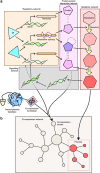Addressing the heterogeneity in liver diseases using biological networks
- PMID: 32201876
- PMCID: PMC7986590
- DOI: 10.1093/bib/bbaa002
Addressing the heterogeneity in liver diseases using biological networks
Abstract
The abnormalities in human metabolism have been implicated in the progression of several complex human diseases, including certain cancers. Hence, deciphering the underlying molecular mechanisms associated with metabolic reprogramming in a disease state can greatly assist in elucidating the disease aetiology. An invaluable tool for establishing connections between global metabolic reprogramming and disease development is the genome-scale metabolic model (GEM). Here, we review recent work on the reconstruction of cell/tissue-type and cancer-specific GEMs and their use in identifying metabolic changes occurring in response to liver disease development, stratification of the heterogeneous disease population and discovery of novel drug targets and biomarkers. We also discuss how GEMs can be integrated with other biological networks for generating more comprehensive cell/tissue models. In addition, we review the various biological network analyses that have been employed for the development of efficient treatment strategies. Finally, we present three case studies in which independent studies converged on conclusions underlying liver disease.
Keywords: Computational biology; Genome-scale metabolic model; Integrated network; Liver metabolism; Omics integration; Systems biology.
© The Author(s) 2020. Published by Oxford University Press.
Figures





Similar articles
-
New paradigms for metabolic modeling of human cells.Curr Opin Biotechnol. 2015 Aug;34:91-7. doi: 10.1016/j.copbio.2014.12.013. Epub 2015 Jan 2. Curr Opin Biotechnol. 2015. PMID: 25559199 Review.
-
Genome-scale modeling of human metabolism - a systems biology approach.Biotechnol J. 2013 Sep;8(9):985-96. doi: 10.1002/biot.201200275. Epub 2013 Apr 24. Biotechnol J. 2013. PMID: 23613448 Review.
-
Characterization of heterogeneous redox responses in hepatocellular carcinoma patients using network analysis.EBioMedicine. 2019 Feb;40:471-487. doi: 10.1016/j.ebiom.2018.12.057. Epub 2018 Dec 31. EBioMedicine. 2019. PMID: 30606699 Free PMC article.
-
Logical transformation of genome-scale metabolic models for gene level applications and analysis.Bioinformatics. 2015 Jul 15;31(14):2324-31. doi: 10.1093/bioinformatics/btv134. Epub 2015 Mar 2. Bioinformatics. 2015. PMID: 25735769
-
Metabolic rearrangements in primary liver cancers: cause and consequences.Nat Rev Gastroenterol Hepatol. 2019 Dec;16(12):748-766. doi: 10.1038/s41575-019-0217-8. Epub 2019 Oct 30. Nat Rev Gastroenterol Hepatol. 2019. PMID: 31666728 Review.
Cited by
-
Development trends of etiological research contents and methods of noncommunicable diseases.Health Care Sci. 2023 Oct 9;2(5):352-357. doi: 10.1002/hcs2.69. eCollection 2023 Oct. Health Care Sci. 2023. PMID: 38938587 Free PMC article. No abstract available.
-
Systems Analysis Reveals Ageing-Related Perturbations in Retinoids and Sex Hormones in Alzheimer's and Parkinson's Diseases.Biomedicines. 2021 Sep 24;9(10):1310. doi: 10.3390/biomedicines9101310. Biomedicines. 2021. PMID: 34680427 Free PMC article.
-
TumorMet: A repository of tumor metabolic networks derived from context-specific Genome-Scale Metabolic Models.Sci Data. 2022 Oct 7;9(1):607. doi: 10.1038/s41597-022-01702-x. Sci Data. 2022. PMID: 36207341 Free PMC article.
-
Stratification of patients with clear cell renal cell carcinoma to facilitate drug repositioning.iScience. 2021 Jun 12;24(7):102722. doi: 10.1016/j.isci.2021.102722. eCollection 2021 Jul 23. iScience. 2021. PMID: 34258555 Free PMC article.
References
-
- Mardinoglu A, Boren J, Smith U, et al. . Systems biology in hepatology: approaches and applications. Nat Rev Gastroenterol Hepatol 2018;15:365–77. - PubMed
-
- Uhlen M, Zhang C, Lee S, et al. . A pathology atlas of the human cancer transcriptome. Science 2017;357:eaan2507. - PubMed
-
- Gatto F, Volpi N, Nilsson H, et al. . Glycosaminoglycan profiling in patients’ plasma and urine predicts the occurrence of metastatic clear cell renal cell carcinoma. Cell Rep 2016;15:1822–36. - PubMed
Publication types
MeSH terms
Substances
LinkOut - more resources
Full Text Sources
Medical
Research Materials

